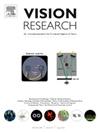8-12岁单侧弱视儿童的非通路视力缺陷
IF 1.4
4区 心理学
Q4 NEUROSCIENCES
引用次数: 0
摘要
传统的视敏度(VA)测试,在白色背景上使用黑色视型,可能不能完全检测到细微的on通路弱视缺陷或视觉黑暗优势的增加。本初步研究验证了反向对比极性、黑色背景下的白光视视检测对弱视的检测比传统视差测试更敏感的假设。研究人员招募了两组8-12岁的儿童。弱视组(N = 13)的最佳矫正视差为20/32或更差,眼间视差差≥0.2 logMAR。正常对照组(N = 16)的最佳矫正眼压等于或优于20/25,眼间眼压差≤0.1 logMAR。使用ETDRS程序,使用弱视治疗研究方案,对每个极性的单眼VA进行测试,并将结果作为评分报告。按随机顺序测试两种视型极性,每隔30分钟重复测试一次。比较弱视组、右眼组和对照组的视电位。对于弱视眼,白色视型的平均VA评分比黑色视型低3.6个字母或约0.07 logMAR,表明弱视眼比黑色视型更难以看到白色。对于同类眼睛来说,白色眼睛的平均得分也明显低于黑色眼睛。在对照眼内,两极性的平均得分无显著差异。我们的研究结果表明,反极性视力测试可以更灵敏地检测儿童弱视。本文章由计算机程序翻译,如有差异,请以英文原文为准。
ON-Pathway visual acuity deficits in 8–12 years old children with unilateral amblyopia
Conventional visual acuity (VA) tests, using black optotypes on white background, may not fully detect subtle ON-pathway amblyopia deficits or increases in visual dark dominance. This pilot study tests the hypothesis that VA testing with reverse contrast polarity, white optotypes on black background, is more sensitive in detecting amblyopia than conventional VA testing. Two groups of children aged 8–12 were enrolled. The amblyopic group (N = 13) had a best-corrected VA of 20/32 or worse in the amblyopic eye and an interocular VA difference of ≥ 0.2 logMAR. The normal control group (N = 16) had best-corrected VA equal to or better than 20/25 and an interocular VA difference of ≤ 0.1 logMAR. Monocular VA was tested for each polarity using an ETDRS program using the Amblyopia Treatment Study protocol, with results reported as a Score. Two optotype polarities were tested in randomized order, and tests were repeated after a 30-minute interval. VA was compared among amblyopic, fellow, and the right eyes of the control group for both polarities. For amblyopic eyes, the mean VA Score was significantly lower for white optotypes than for black optotypes by 3.6 letters or approximately 0.07 logMAR, indicating that amblyopic eyes had more difficulty seeing white than black optotypes. For fellow eyes, the mean Score was also significantly lower for white than for black optotypes. No significant differences in mean Scores between two polarities were found within the control eyes. Our findings suggest that visual acuity testing with reverse polarity could be more sensitive to detect amblyopia in children.
求助全文
通过发布文献求助,成功后即可免费获取论文全文。
去求助
来源期刊

Vision Research
医学-神经科学
CiteScore
3.70
自引率
16.70%
发文量
111
审稿时长
66 days
期刊介绍:
Vision Research is a journal devoted to the functional aspects of human, vertebrate and invertebrate vision and publishes experimental and observational studies, reviews, and theoretical and computational analyses. Vision Research also publishes clinical studies relevant to normal visual function and basic research relevant to visual dysfunction or its clinical investigation. Functional aspects of vision is interpreted broadly, ranging from molecular and cellular function to perception and behavior. Detailed descriptions are encouraged but enough introductory background should be included for non-specialists. Theoretical and computational papers should give a sense of order to the facts or point to new verifiable observations. Papers dealing with questions in the history of vision science should stress the development of ideas in the field.
 求助内容:
求助内容: 应助结果提醒方式:
应助结果提醒方式:


